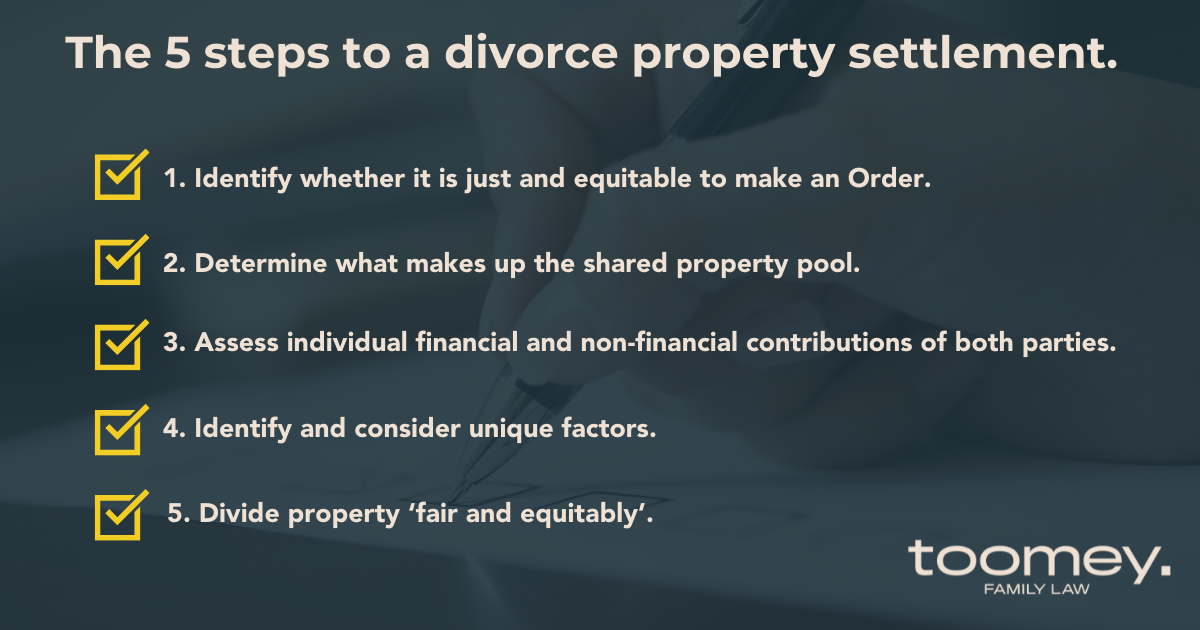
01 Jul Divorce Property Settlement – How Much Will I Get?
Divorce Property Settlement – How Much Will I Get?
There’s a recurring myth among Australians that divorce means a 50/50 split of assets. But despite the tenacious nature of this idea, in the case of a separation or divorce, an even split of the property pool is not generally the result.
While Australia does have a ‘no-fault’ divorce rule when it comes to the division of property both the contributions and the needs of each party will be taken into account. The fact is that the contributions of each party to a relationship are different. And the needs of each party after a divorce or separation are different as well. So, when it comes time to divide your property pool, the outcome will be highly dependent on your individual and family situation.
Of course, there are some general guidelines to follow and outcomes that the courts look to achieve. These will impact how much you will get if you divorce or separate. Let’s take a look.
The 5 Steps to a Divorce Property Settlement
How property is divided in the case of separation or divorce is governed by guidelines set out in the Family Law Act 1975 (Cth). In general, you and your ex-partner will get together with your lawyers to come to an agreement on the division of property. This will then need to be confirmed by the courts.

Step 1: Identifying Whether It Is Just and Equitable to Make an Order
This means that the Federal Circuit and Family Court of Australia (FCFCOA) has to be satisfied that it is in the interests of both parties that an Order to adjust property between them is appropriate. Aspects taken in taken consideration are the length of the relationship, children, how assets have been treated in the relationship (i.e. have they been quarantined or treated separately from other assets) etc.
Step 2: Determine What Makes Up the Shared Property Pool
Determining the property pool is the first, and sometimes most time-consuming, step when dividing up property. It’s a simple concept – the process of pulling together information about all the assets and liabilities that you and your ex-partner share. But it can be difficult to get it all together.
Your property pool could include:
- Real estate
- Vehicles
- Savings
- Superannuation
- Interests in companies
- Investments
- Debts such as personal loans and credit cards
- Tax liabilities
Remember that the property pool will include all of your assets and liabilities – even those that are only in one partner’s name or that were held before the marriage. If you only consider things that are held jointly, one party could be disadvantaged.
Step 3: Assess the Contributions of Each Spouse
Once the parties have pulled together the property pool, the next step is to consider the contributions that each party has made to the overall property pool. It’s important to remember that contributions are both financial and non-financial. And neither is considered to be fundamentally more important than the other.
Contributions can include:
- Income earned
- Caring for children
- Homemaking
- Property renovations
- Gifts or loans from family
- Non-financial family support (like grandparent childcare)
The longer the length of the relationship, the less of a factor these individual contributions become. In general, if your relationship has lasted around 15 years, your contributions and those of your ex-partner will likely be considered essentially equal. Of course, this is always dependent on individual circumstances.
Step 4: Identify and Consider the Unique Factors That Apply to You and Your Family.
As a fourth step, you will need to identify and consider the factors that are unique to you and your family. These factors are used to determine how to divide the property in a way that is fair and doesn’t leave one party disadvantaged.
Some of the factors that you’ll need to consider for both you and your ex-partner are:
- Your ages
- Your health
- Your income and ability to earn income in the future
- Your ability to support yourself
- Your childcare responsibilities (for children under the age of 18)
- Whether you have care responsibilities for another person or dependent
- Your eligibility for a pension, allowance, benefit or future inheritance
- How the marriage has affected your ability to earn
- Any child support responsibilities
- The terms of any relevant financial agreement (for example, a prenuptial agreement)
Step 5: Divide the Property Up in a ‘Fair and Equitable’ Way
Once you’ve identified all the factors that apply to you, your ex-partner and your family, you need to balance these against one another. If, after you’ve balanced the factors, one of you will be worse off than the other, then you’ll need to provide an additional part of the pool to that party to balance this out.
For example, a spouse who has sacrificed earning capacity during the marriage by focusing on the home or family might then need an extra part of the property pool. Or the spouse who will primarily care for the children might get an extra part as well. The goal is simply to ensure that the division is fair and that no party is left in a compromised position.
So, What Are You Entitled To?
What you’re entitled to when you’re settling your property after divorce or separation will be unique to you and your situation. But determining that is a balancing act. It comes down to understanding what’s in your property pool, considering your contributions and needs and then dividing the pool to make it fair and equitable.
Of course, utilising the services of an expert property settlement specialist like our Toomey Family Law lawyers can help streamline the process and generate better outcomes. And we can help you navigate a difficult situation with sensitivity and ease.





